Tourmaline is very popular and there are a ton of reasons why. For one, there are so many different varieties with each one having unique colors.
Now take into consideration the crystal structure and you have yourself a world-class specimen for collectors to go after. From single crystal points all the way to unique crystal clusters on rare matrices, these crystals are a must-have for any collection.
If you’re new to learning about Tourmaline then you should take some time to understand the “A” axis and the “B” axis because Tourmaline can display a completely different color depending on which direction the light passes through the crystal and into your eye.
Types of Tourmaline
The incredible rainbow of colors for Tourmaline sets it apart from other gemstones because you can source material in blues, greens, reds, pinks, browns, yellows, and black, and there are even colorless varieties. Here’s a short list of Tourmaline types you should research and consider adding to your collection.

Dravite
Dravite is commonly known as Brown Tourmaline. It’s a relatively common form of gemstone and often forms in rather crude and uninteresting formations compared to other varieties. This stone can be partially replaced or intergrown together with Schrol Tourmaline.
In some cases, like the one above, you can have a crystal with a green tip and a brown base or core.
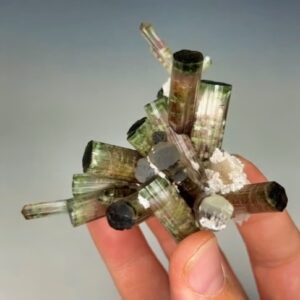
Elbaite
Elbaite is one of the most well-known and valuable varieties of Tourmaline. Most of the multicolored and nearly all of the Tourmaline gems are of the Elbaite variety.
When looking at an Elbaite Tourmaline crystal you notice several interesting optical properties. Many of the blue and green specimens are strongly pleochroic. When they’re viewed through their vertical axis, the specimens appear darker in color than when looked at through their horizontal axis.
You can even find Elbaite Tourmalines displaying a cat’s eye effect when polished into cabochons.
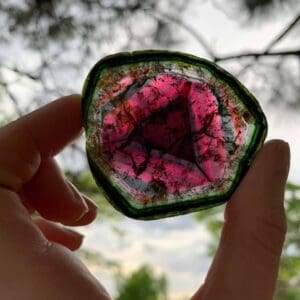
Liddicoatite
Liddicoatite is a relatively uncommon form of Tourmaline, and it’s nearly identical in chemical composition to Elbaite. However, there is a calcium atom replacing a sodium atom. These gemstones weren’t recognized as an individual Tourmaline variety until 1977. Before that, it was considered to be Elbaite.
We will leave it up to the experts to determine whether or not a Tourmaline specimen is Elbaite or Liddicoatite because I don’t have the equipment to confirm or deny that a calcium atom has been replaced by a sodium atom. Quite honestly, I’d rather own the slice of Tourmaline above and not worry too much about it.

Uvite
Uvite is another uncommon variety of Tourmaline. It forms different crystal formations than most of the other Tourmaline species. While it lacks the color diversity of many Tourmaline, it occurs in incredibly beautiful green and reddish-brown hues.
Uvite also forms as lustrous submetallic crystals.
The name Uvite is derived from the locality of the Uva Province in Sri Lanka, where the gem was first identified.
Uvite is incredibly similar to Dravite Tourmaline, and they will sometimes form together in a single crystal. However, it can sometimes be very challenging to make exact distinctions between Uvite, Dravite, and the more recently designated Fluor-Uvite.
The biggest take away is the crystal structure and how it differs from the other Tourmaline varieties listed.

Paraiba
Paraiba Tourmaline is a variety of Tourmaline that was first discovered in Paraiba, Brazil, and is the most sought-after variety of Tourmaline. This neon blue color is extremely intense when seen in person and you understand why everyone wants to own one of these.
Its color is derived from a higher copper content which makes it very rare. Most of the time you’ll never see quality material hit the commercial market but if you know the right gem dealers and you’re patient then you’ll eventually get a chance at buying a piece.
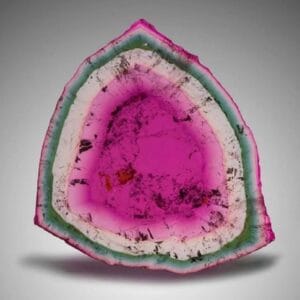
Watermelon
Watermelon Tourmaline is characterized by its pink or red center and green exterior which resembles a slice of watermelon. Take a look at the image above and you’ll understand why these are highly collectible.
Authentic watermelon Tourmaline is rare and difficult to source. You’ll see specimens, thinly sliced crystals, and faceted material when visiting a gem and jewelry show.
When viewing the crystal through the “A” axis you’ll notice a pink or red center surrounded by a green rim that’s often separated by a pale pink, white, or silver line. The brightly colored zones can occur on either end of the gem, although there’s a bit of debate as to whether or not these crystals should be classified as Watermelon. Some feel as though it would be more appropriate to classify them as bi-colored.
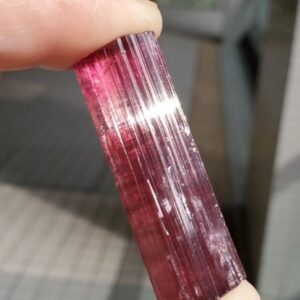
Rubellite
Rubellites are a beautiful variety of Tourmaline with relatively saturated dark pink to red hues and medium to dark tones. These stones make exceptional jewelry, and the ruby-colored specimens lacking brown or orange overtones are highly prized and sought-after. For a long time, this material was difficult to source but there have been new mine discoveries that flooded the market with material driving the price lower, for a short period.
Trace amounts of manganese are responsible for creating this gem’s natural dark pink-to-red color. However, you might encounter light pink gemstones labeled as Rubellites, but they’re more appropriately considered Pink Tourmaline.
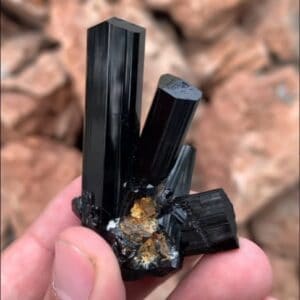
Schrol
Schrol is well-known by many as Black Tourmaline. While there are other forms of Tourmaline that can be black, Schorl is exclusively black.
Unlike other Tourmaline varieties, this gemstone is never transparent or translucent. In a few rare instances, Schorl Tourmaline can be intergrown together with Elbaite, creating a specimen that’s part of Schrol and Elbaite.
This gemstone is the most common form of Tourmaline and is very popular among enthusiasts. It has high luster and beautiful crystal formations making it the most aesthetic black mineral around.
FUN FACT
Tourmaline stones are renowned for their electric properties. Yes, you read that correctly. When a Tourmaline is subjected to pressure or heat, it develops an electric charge at its ends, which results in the polarization of the stone. This incredible phenomenon is known as pyroelectricity or piezoelectricity. This phenomenon is one of the many reasons Tourmaline is such a valuable stone in industrial applications and scientific instruments.
- Identify Enstatite - March 12, 2024
- Identify Cerussite - March 3, 2024
- Identify Bytownite - February 18, 2024
